It’s got a good reputation the Petri Color 35. It seems to be relatively unknown, but from those who do know the camera, it seems to garner high praise – Dan who took this shot for me speaks very highly of it. I’ve had mine for quite a long time, and whilst I’ve always found it a neat little camera, I’ve never really committed to shooting with it. I recently decided it was time to change that…
I came to the conclusion that the best way to commit myself to shooting it was committing myself to writing about it. I included it in a poll that was to dictate the order in which I wrote about the cameras in question. In fact, if it hadn’t been for the poll being swung for the AiBORG by a mate of mine, the Petri would have probably won the race to be reviewed first – it was certainly the camera that attracted the most positive commentary from people. The odd thing was, I wasn’t that bothered that the AiBORG got in the way, I even let another camera (the Olympus mju iii wide 100) push the queue. So what’s the problem with this camera, why haven’t I been as enticed into shooting it as I have been with so many other cameras?
The comparison trap
I think the biggest problem I’ve had with the Petri Color 35 is the comparison trap – it doesn’t get used because of small comparisons with other cameras that feel like they are getting in the way. The most noteworthy protagonist in this story being the Rollei 35SE. Comparisons are made between these two cameras all the time – they often state the primary positive attribute of the Rollei as having a better lens than the Petri. Because of this – and despite the fact that the Petri is often referred to as having a more logical and easy to use design – I’ve just been less inclined to pick it up. Then there’s the comparison to the Olympus 35rc – a camera that despite its tiny size manages to include a rangefinder, a feat not “achieved” by the little Petri.
The obvious response to this is that the Rollei doesn’t have a rangefinder either, but where the Rollei lacks a rangefinder, it is does at least have a conventional focusing scale that shows the depth of field on top of the lens – not something that can be said of the Petri Color 35. I shall share my thoughts on these features and comparisons in more depth throughout the post, I’m just trying to paint a picture of a camera that for one reason or another has found its way to the back of my camera shelf.
Of course, the reality is, these comparisons aren’t really fair ones to make, not at least until I’ve shot with the thing. Rather than paling in the comparison to its peers, what the Petri might actually represent is an entirely unique camera. It is after all a camera that conquers the challenges of miniaturisation in some ingenious and quite fascinating ways. Whatever the reality, it was time I found out! The problem was – at least to start with – my experience didn’t go all that smoothly.
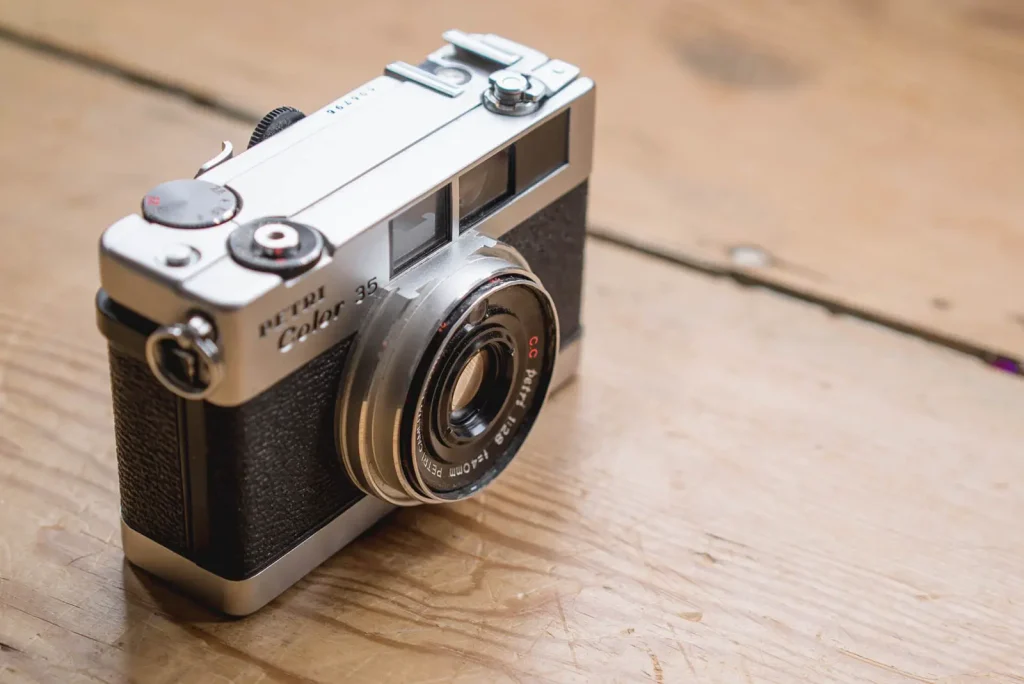
Off to a bad start
Just prior to using the Petri Color 35 I’d been getting distracted again by a point & shoot Olympus, and after that could feel me getting distracted by the Leica M5. The one morning I decided to just bite the bullet, put a film in it and take it out. Unfortunately, once out of the house, my experience went down hill quickly. I took it on a walk with the dogs. I don’t often take that many photos when I go out with the dogs by myself as I quite often just go up a few roads, round a little park, and back home. I’ve walked this walk literally hundreds of times, so don’t feel particularly inspired to take photos. This occasion was no different, I chucked the camera in my pocket, and didn’t take it out – not to take photos at least. The first time it came out of my pocket was after fiddling with it in my pocket and the little rewind lever came unscrewed and popped off. I couldn’t have been more frustrated with myself. Having not used it before in any real way, the first time I do, I go and break the damned thing. Making sure not to lose any parts, I gently returned it to my pocket and walked home, cursing myself and the little Petri in the process.
Fixing a camera and a relationship
Once I got home, I just plonked it and it’s fallen-off bit back on the shelf. There was a moment when I figured I’d just not use it after that. This was until I decided I could write this little post about fixing it. It was surprisingly easy in the end. But, more important than the fix itself was the quite sizeable increase in desire to use the thing – pride in the achievement of fixing it I suppose – or perhaps we bonded in its moment of need…? Either way, I now had a greater motivation to take it out, so take it out I did. In fact, for the last week or so it’s gone almost everywhere with me. The funny thing is, even with all the use its had, coming to a conclusion about it has still not been as simple a process as it could have been…
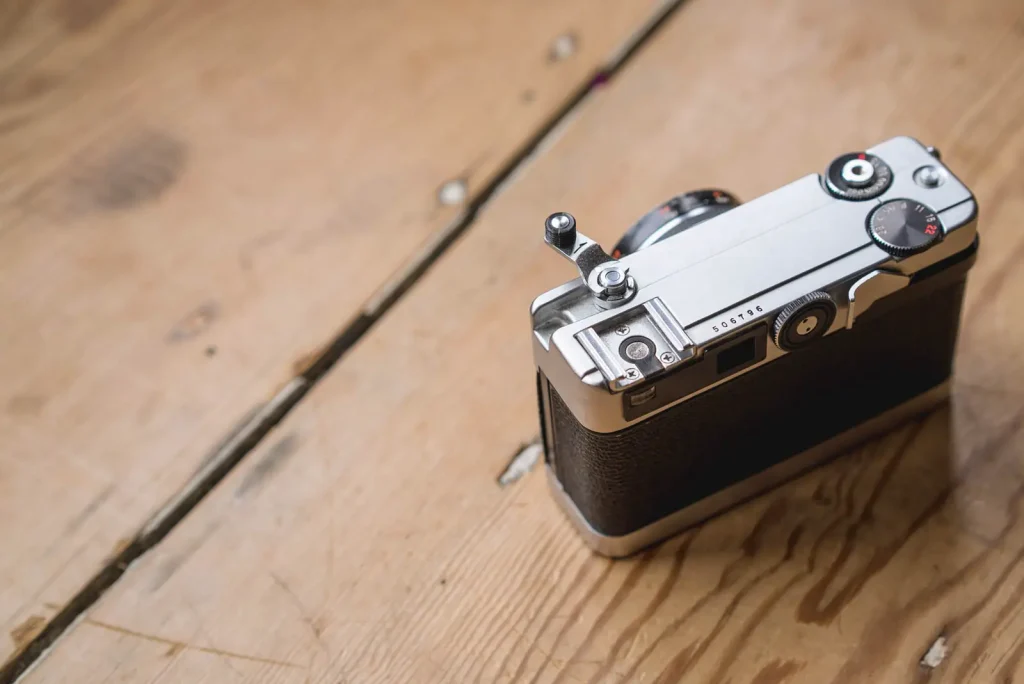
Petri Color 35 Review
When I began using this camera, there was something that cropped up that somewhat hindered my thought process about the direction this post was going to go. What I found was that whatever my personal feelings toward one of its features, I could also so readily see the opposing opinion. I find this more and more when I’m writing about cameras, especially with older cameras like this – and with good reason. Unlike many modern cameras that seem genuinely functionally flawed, with many of these older cameras, where features might not be perfect for the individual, they are also so simplistic, it’s easy to see the appeal – especially when they are part of such a well functioning whole. In the context of he Petri Color 35, the feature I’m talking about is its focusing system.
Focusing the Petri Color 35
The best place to start in describing the Petri Color 35’s focusing system is with the fact that it has a collapsible lens. There is a wheel on the top back of the camera that you can control with your forefinger when you have the camera to your eye. Winding this wheel first moves the lens from its collapsed position into its shooting position. Once into the shooting position the wheel then becomes the method for which the camera is focused.
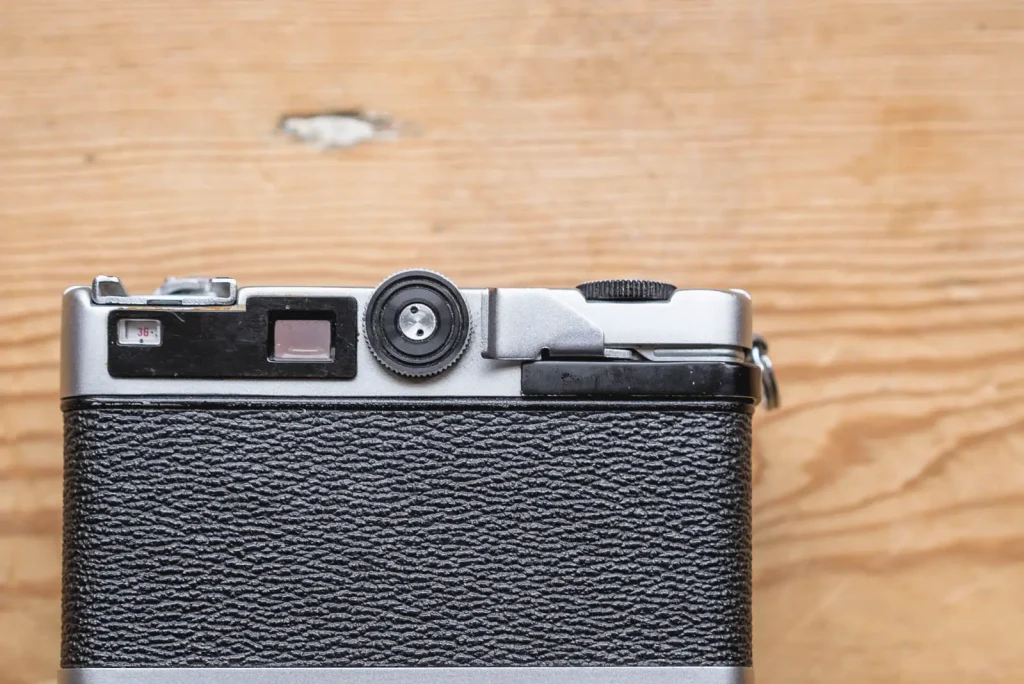
When looking through the viewfinder correct focus is obtained by reading a scale visible at the bottom of the viewfinder. A small needle moves back and forth as the wheel is turned, pointing at the distance the lens is focused to.
Basic & intuitive, yet limiting and frustrating.
The wheel turns in the same direction as the needle moves, and the amount the needle responds to movement in the wheel seems just right. Inside the viewfinder distances are displayed in both feet and meters with scale diagrams of a persons head, a group of people and some mountains to help you on your way too. Because of this, with the camera to your eye, it feels incredibly intuitive to use.
So what’s the problem then? Well, whilst it is quite an elegant solution to the problem of focusing, it’s not going to suit everyone. The main issue with the way the Petri Color 35 is focused is that this scale only visible through its viewfinder – there are no distance marks on the lens. There is also no way of telling the depth of field at a glance since even in the viewfinder, the needle only points at the focused distance, it doesn’t indicate depth of field.
As such, for people who are good at judging distance and like or don’t mind focusing a camera shot-by-shot with the camera to their eye, this system is going to be fine. Though, as someone who quite often likes to frame a photo at the very last moment, pre-focusing using a depth of field scale first, it can feel a little limiting – and for some reason, quite difficult.
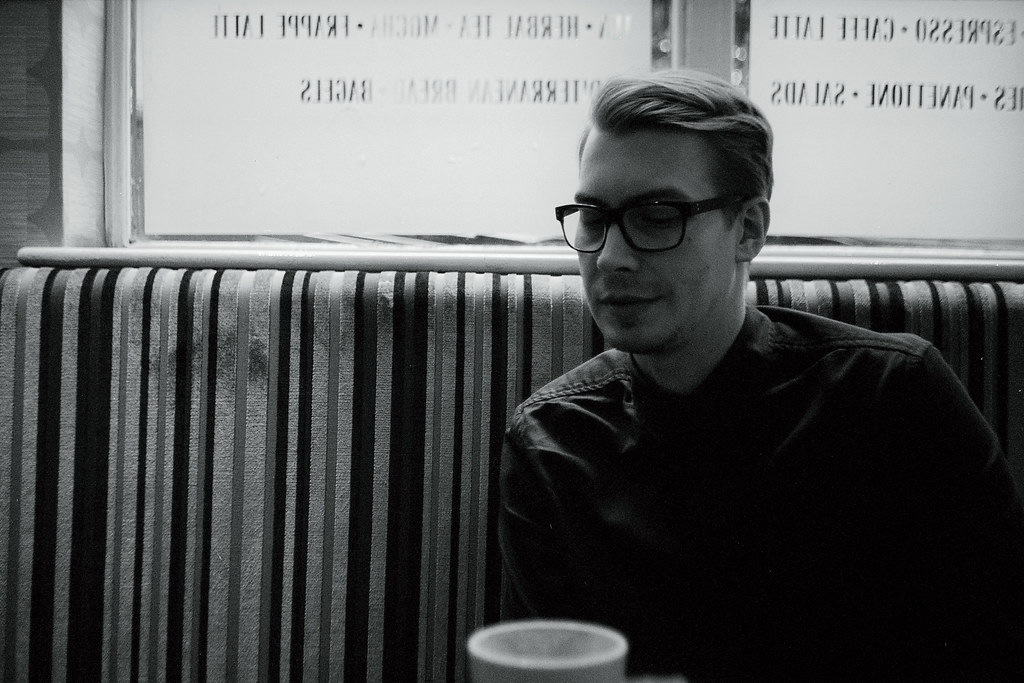 There have been a few shots I’ve missed focus, as in the shot above my estimation of distance at the point of shooting was clearly wrong. I suffer this problem far less when I have a depth of field markings to help me on my way.
There have been a few shots I’ve missed focus, as in the shot above my estimation of distance at the point of shooting was clearly wrong. I suffer this problem far less when I have a depth of field markings to help me on my way.
A counterpoint to my own issue
Of course I can quite readily argue with myself here and suggest that all you need to do is remember the distance you focused for the last shot between each shot. Combined with a little knowledge of the depth of field at various apertures at various distances with a 40mm lens, you could probably snap away. For example, just like with both the Rollei 35se and Olympus 35rc, you can set it to f11, focus to 5 meters and shoot away happy in the knowledge you have everything from 2.25m to infinity in focus. And in fact, since the shutter speed dial only goes up to 1/250th, if you are like me and shoot a lot of 400iso even in summer, you might well be happy at f16 too. f/16 gives depth of field of 1.5m to infinity at around 3.00 meters. So, for most sunny-daytime shooting it can be focused once using the scale in the viewfinder and then all but forgotten about. You could also print off this page of the manual if you so desired 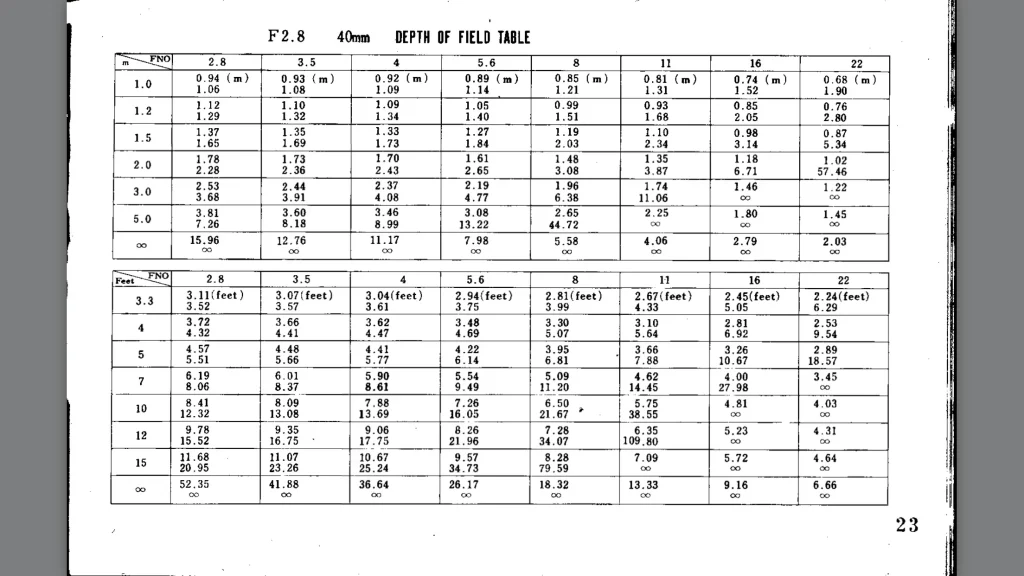 The full manual where I took that screen grab from is also available here on Butkus.org The problem is with zone focusing the camera – beyond of course the necessity to be able to remember a lot of numbers or carry a bit of paper (or phone app) around with you – is that actually, this camera doesn’t feel like it’s designed to be used this way when you take into account the way the meter and shutter/aperture controls work… Let me explain…
The full manual where I took that screen grab from is also available here on Butkus.org The problem is with zone focusing the camera – beyond of course the necessity to be able to remember a lot of numbers or carry a bit of paper (or phone app) around with you – is that actually, this camera doesn’t feel like it’s designed to be used this way when you take into account the way the meter and shutter/aperture controls work… Let me explain…
The shutter, aperture and light meter
Just like the focusing system, the shutter and aperture controls are quite simple in their design and elegant in their function. The shutter dial that hangs over the front of the camera is clicked between its B, 15, 30, 60, 125 & 250 settings – it is also perhaps a little stiff to rotate. The aperture control that hangs over the back of the camera and sits under the thumb, is click-less, and rotates with ease. 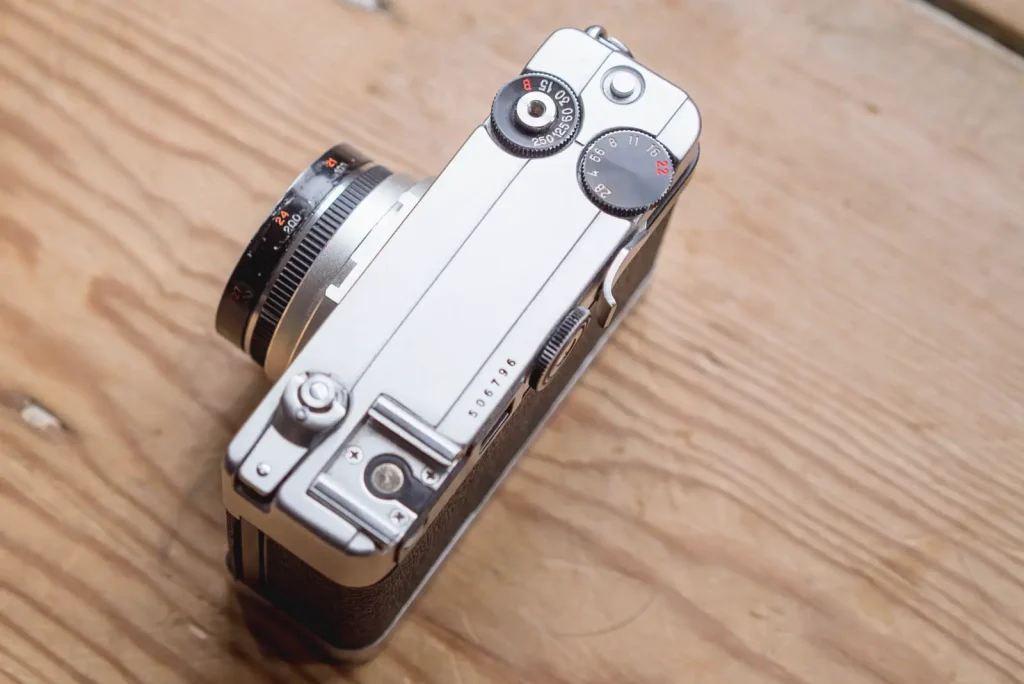 The light meter is a needle based meter that swings up and down on the right hand side of the viewfinder. It gives a logical up-is-over/down-is-under readout, and whilst it is a little limited in its range with it only working down to 7ev, that’s to be expected of a camera of this age.
The light meter is a needle based meter that swings up and down on the right hand side of the viewfinder. It gives a logical up-is-over/down-is-under readout, and whilst it is a little limited in its range with it only working down to 7ev, that’s to be expected of a camera of this age.
Shooting by design
What’s most interesting about these features though is how that when you start to use them, you almost feel as though you are being nudged into using the camera in a specific way – perhaps indeed, the way it was designed to be used. Since the aperture is un-clicked, and since the shutter speed dial is slightly stiff and has so few speeds, there is a sense that the easiest method of selection of correct exposure value when the camera is to the eye is via the aperture control. Because the camera is focused with the camera also to the eye, and by distance not zone, adjusting the aperture is less likely to cause detriment to the outcome than adjusting the shutter speed. What I mean by this is whatever the aperture is set to, the focused subject will be in focus – at very least at the point of chosen focus distance. By trying to change the shutter speed with the camera to the eye – with the shutter speeds not being visible in the viewfinder – there is a danger an inappropriate speed might be selected by accident.
Manual, shutter priority
In short, what I am getting at is that this camera feels like its designed to be used almost like it’s a shutter priority camera. 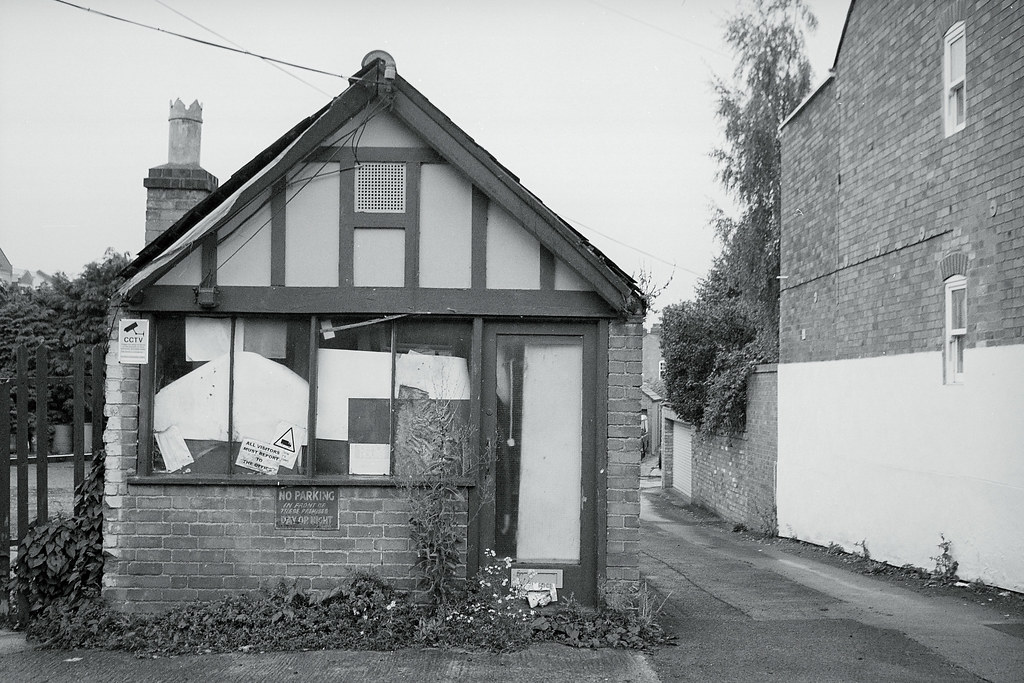
Take this photo of a building. I was outside and it was reasonably bright. I’ve got 400iso film inside. Because of this before I put the camera to my eye I decide on a faster shutter speed. I set the camera to 1/250th, the put the camera to my eye. I adjust the camera to get correct exposure by adjusting the aperture so the meter needle sits in the centre. I then focus to between 5m and infinity, then reframe and shoot. My actual shot aperture didn’t matter that much, I know it’s going to be small because it’s bright enough, and since I’m focusing at a distance, I know my depth of field is going to be adequate for my subject.
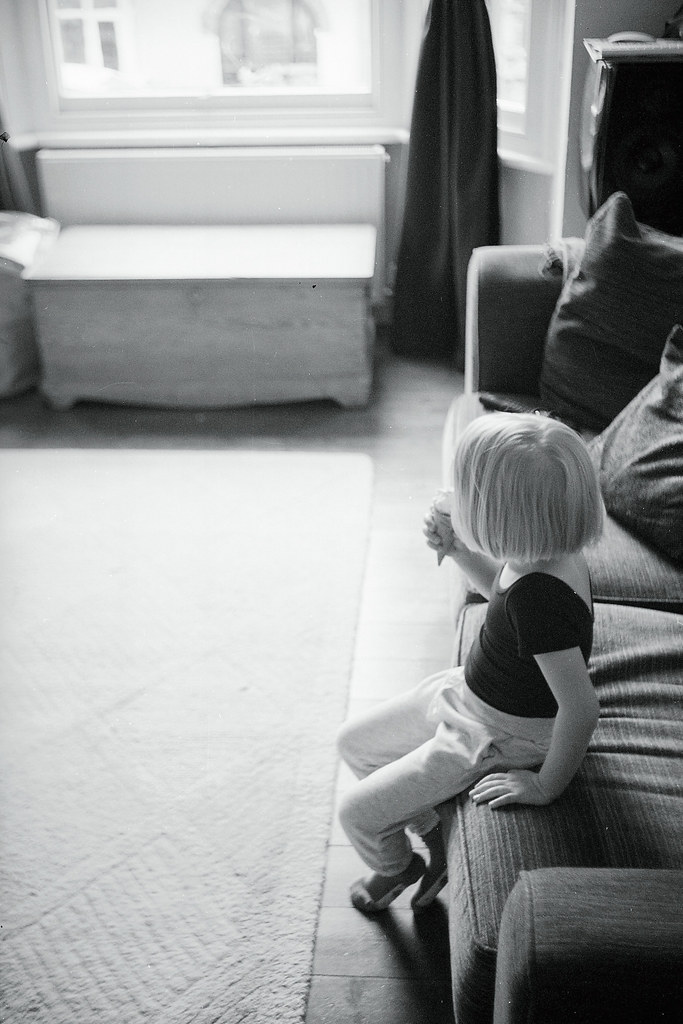 Another very different example of shooting like this is this shot of Connie in my lounge. I knew I was shooting indoors so light is a factor, but I also knew I was shooting a Connie – a subject that has potential to move – so 1/60th is about the safest balance. I also have in the back of my mind that because I’m in quite close proximity to Connie, the smaller the aperture the better chance of getting focus – a slightly slower shutter speed will aid that if I can get away with it. I put the camera to my eye set my focus distance, metered off the sofa using the aperture control, the took the shot. Now obviously the camera is fully manual so it’s not really shutter priority, but this process of set shutter, then let the aperture be chosen by the light just feels the right way to use it. Even outside of this way of shooting though, it is enormously intuitive to work with. Since the controls are sat on top of the camera and are next to each other, they can be seen together and understood in a glance. Additionally to this, changing setting reciprocally is very easy. The shutter and aperture dials turn in opposite directions and are joined by a little line between them that points at the selected setting. If you looked through the viewfinder, took a reading, then after looking at the top of the camera decided the settings weren’t as you wished, finding that appropriate different reciprocal settings is very easy indeed!
Another very different example of shooting like this is this shot of Connie in my lounge. I knew I was shooting indoors so light is a factor, but I also knew I was shooting a Connie – a subject that has potential to move – so 1/60th is about the safest balance. I also have in the back of my mind that because I’m in quite close proximity to Connie, the smaller the aperture the better chance of getting focus – a slightly slower shutter speed will aid that if I can get away with it. I put the camera to my eye set my focus distance, metered off the sofa using the aperture control, the took the shot. Now obviously the camera is fully manual so it’s not really shutter priority, but this process of set shutter, then let the aperture be chosen by the light just feels the right way to use it. Even outside of this way of shooting though, it is enormously intuitive to work with. Since the controls are sat on top of the camera and are next to each other, they can be seen together and understood in a glance. Additionally to this, changing setting reciprocally is very easy. The shutter and aperture dials turn in opposite directions and are joined by a little line between them that points at the selected setting. If you looked through the viewfinder, took a reading, then after looking at the top of the camera decided the settings weren’t as you wished, finding that appropriate different reciprocal settings is very easy indeed!
The split in my own opinion
As you might have gathered, this all presents me with somewhat of a split in my own opinion. One half of me sees a quite ingenious and very intuitive focusing system that’s married with a metering and exposure system that compliments it perfectly to make a camera that just seems to make sense in use. The other half of me then sees a focusing system that sits somewhere between the two methods of focusing I ordinarily enjoy, and as such presents me with something that I don’t entirely gel with. The fact is though, beyond my own preferences, the only objective flaws I could find with the Petri Color 35 are a tiny bit of play in the focusing wheel, and that sometimes I catch my eyebrow hair between the wheel and my finger – and the latter could just as easily be an issue with my face, rather than the camera. I find all this a frustrating reality that leaves me feeling not quite as positive about this camera as I feel it deserves me to be… I love the way it works, it just seems to function perfectly as a whole, it’s just not quite perfect for how I personally prefer to shoot. 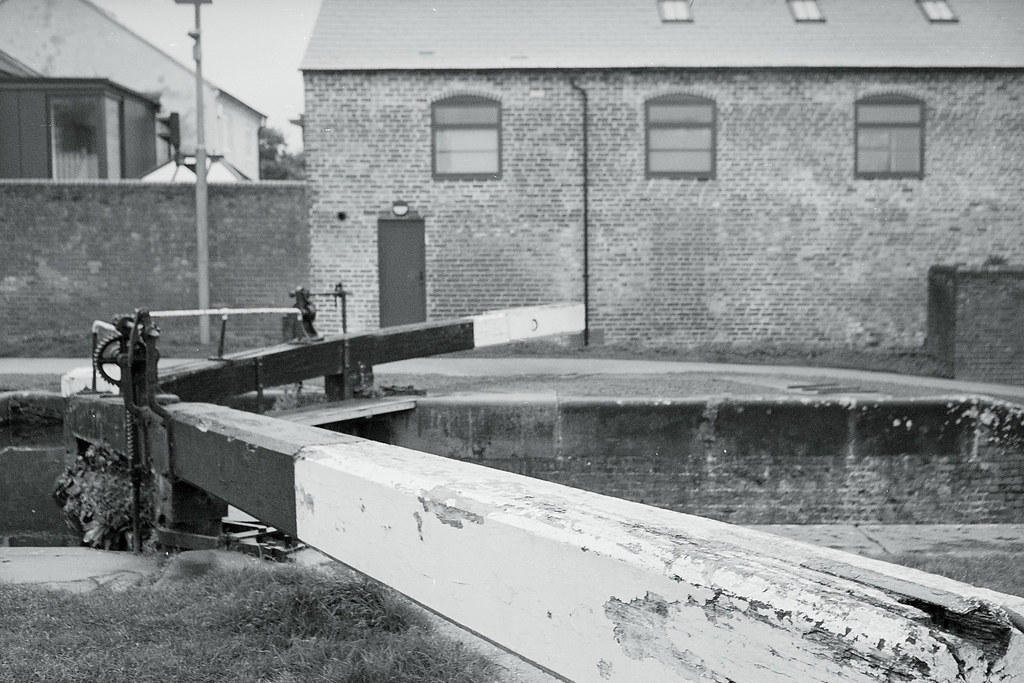
The biggest issue really being that I am actually not all that good with it! The above photo, though isn’t that big a failure in the end, wasn’t supposed to look that way. I’d not intended the point of focus to be so close to me, nor had I wanted such a narrow depth of field.
This frustration is compounded even further by the fact that even beyond the positive attributes I have so far described, the Petri Color 35 is a also really nice camera to hold and to use.
A tactile pleasure
I guess I might have portrayed a certain level of distrust in the build of this camera when I previously spoke about the part of it that I managed to wiggle off whilst fiddling with it in my pocket? Well, there’s a good reason I was playing with it in my pocket – it just feels so good to play with! (I’m talking about the camera….! Get that mind out the bin…!).
Everything about this little camera feels solid, and that’s especially the case when it’s compared to the Rollei 35SE which feels somewhat thin and easy to dent by comparison. The Petri Color 35 feels like the metal it’s made of is thick and could take a bash or two. The same can be said of the mechanics of the thing – the film advance/shutter cock feels mechanically precise and satisfying to use. The only part of my Color 35 that feels anything but precise is the focus wheel which as mentioned has a tiny amount of play in it. Everything else – even the bit I fixed after it fell of – feels well made.
If I had one criticism of how it feels in the hand, it would only be a slight one. Because of its small size, it can feel ever so slightly clumsy to use – a little like the controls aren’t quite in the most ideal place. The best example of this is the aforementioned focusing wheel being a little to close to my eyebrow, but the shutter and aperture controls also feel slightly clumsily positioned when the camera is to the eye too. Of course, this is mostly down to the fact that it’s a tiny camera, and for that reason I broadly forgive it!
The Lens
Of course all this meandering rambling would be completely irrelevant if it didn’t take good photos. But of course, it does take perfectly good photos… I must admit to not being quite as bowled over by them as I was with the Rollei, though by all accounts this was to be expected.
The Rollei lens has a certain charm that’s befitting of its age, yet somehow manages to also take remarkably sharp and quite contrasty images. It’s a little like a vintage Leica lens in that respect – sometimes you can get caught out by flare, but for the most part its very impressive indeed. The Petri Color 35 on the other hand, is definitely more showing of its age in the images. They aren’t as sharp or contrasty as those out of the Rollei, and there is definitely more of a fall off in sharpness toward the edges/corners.
That said though, I wasn’t disappointed. Rating a camera by its lens when compared to another camera known for having an exceptional lens is always going to end in some level of disappointment. But when judged it by its own merits, it is definitely a perfectly capable lens! See for yourself…
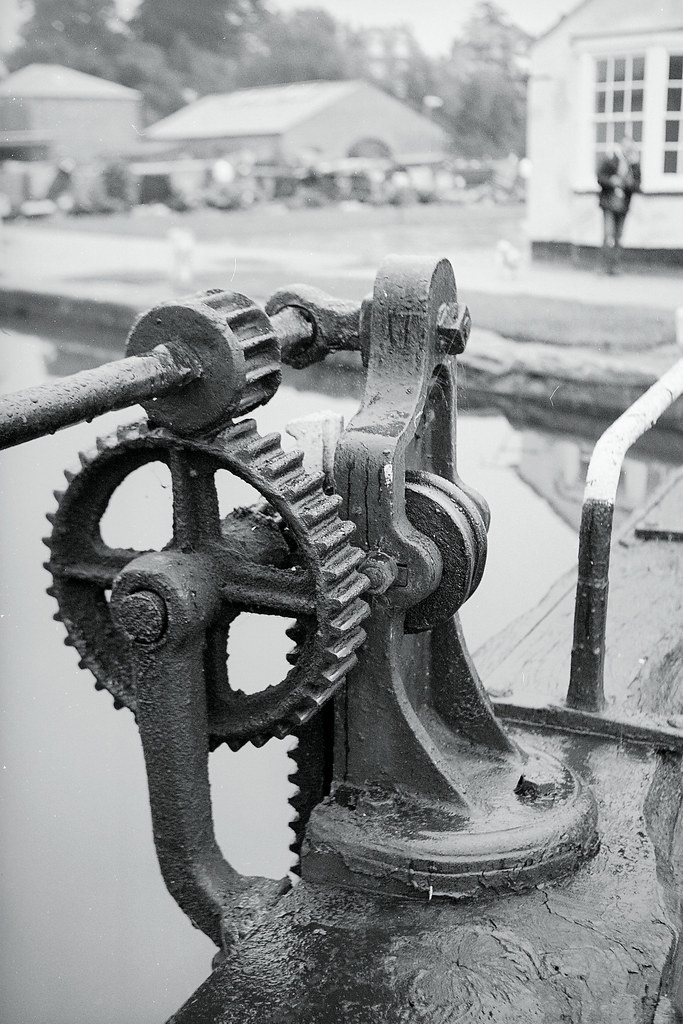
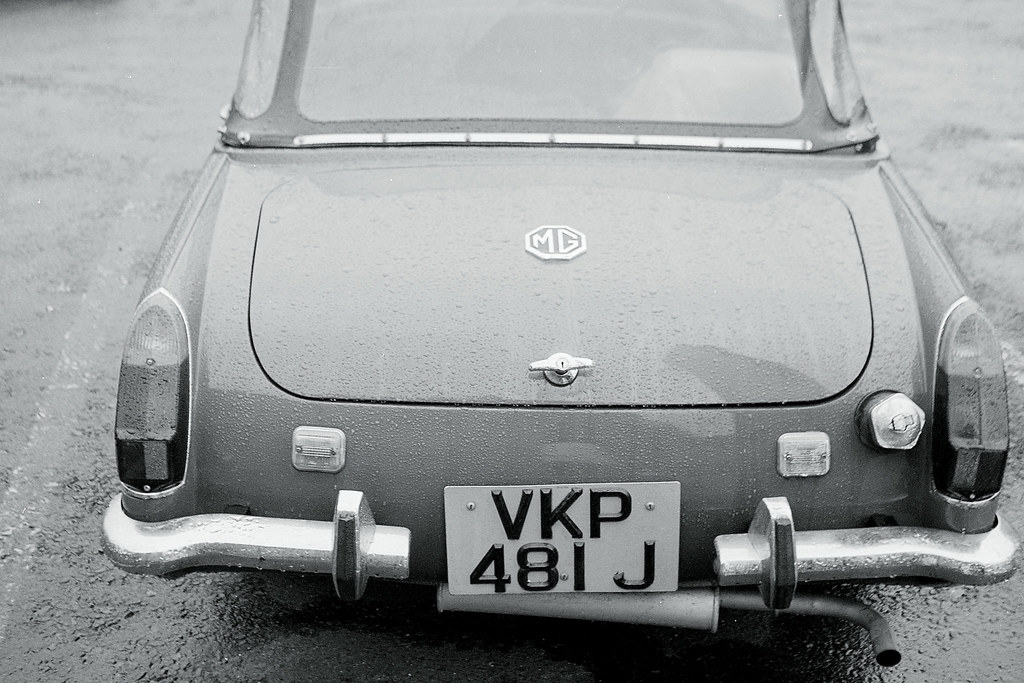
In conclusion
Whilst writing about the Petri Color 35 it feels a little like I’ve been overly harsh on it – and that actually I could have been just as negative about the Rollei 35SE. After all, the Rollei is a camera that relies entirely on zone focusing and doesn’t even have any focus confirmation in the viewfinder. The difference is, I like zone focusing, and Rollei reminded me of this fact in a very pleasing way. The Petri Color 35 feels like it’s going to remind me that I like zone focusing, but then doesn’t really give me an easy way to do it. I also like rangefinders, and am quite happy focusing a camera to my eye with one. But the Petri’s to-the-eye method of focusing doesn’t quite give me what I’m looking for either. In short, somehow the Petri’s focusing system seems to just sit between the two methods of focusing I enjoy in a slightly uncomfortable way.
Deserving of respect
Of course, not everything about the Petri Color 35 leaves me with such mixed or negative feelings. If you do gel with the focusing system, then there really is quite a lot else to also get excited about. It’s small, it might be a little fiddly, but feels like a solid bit of kit that could take much more of a serious bashing than any Rollei 35 could. It also takes great photos, that perhaps to the picky might not be up there with that of the Rollei’s Sonnar, but are still pretty good if you ask me.
So will it replace the my Rollie 35SE as my choice fully manual pocket camera? Well, no I do prefer the Rollei, for all its eccentricities, it’s just a more enticing camera to use. But, if you asked me if I thought my comments should make you think twice about trying a Petri Color 35, I’d also say no! For the £50(ish) they can be picked up for they are superb little cameras that go beyond the great photos they take and give you a real sense of near perfect design in use (even if like me you don’t quite gel with how it works).
Cheers for reading
Hamish
Share this post:
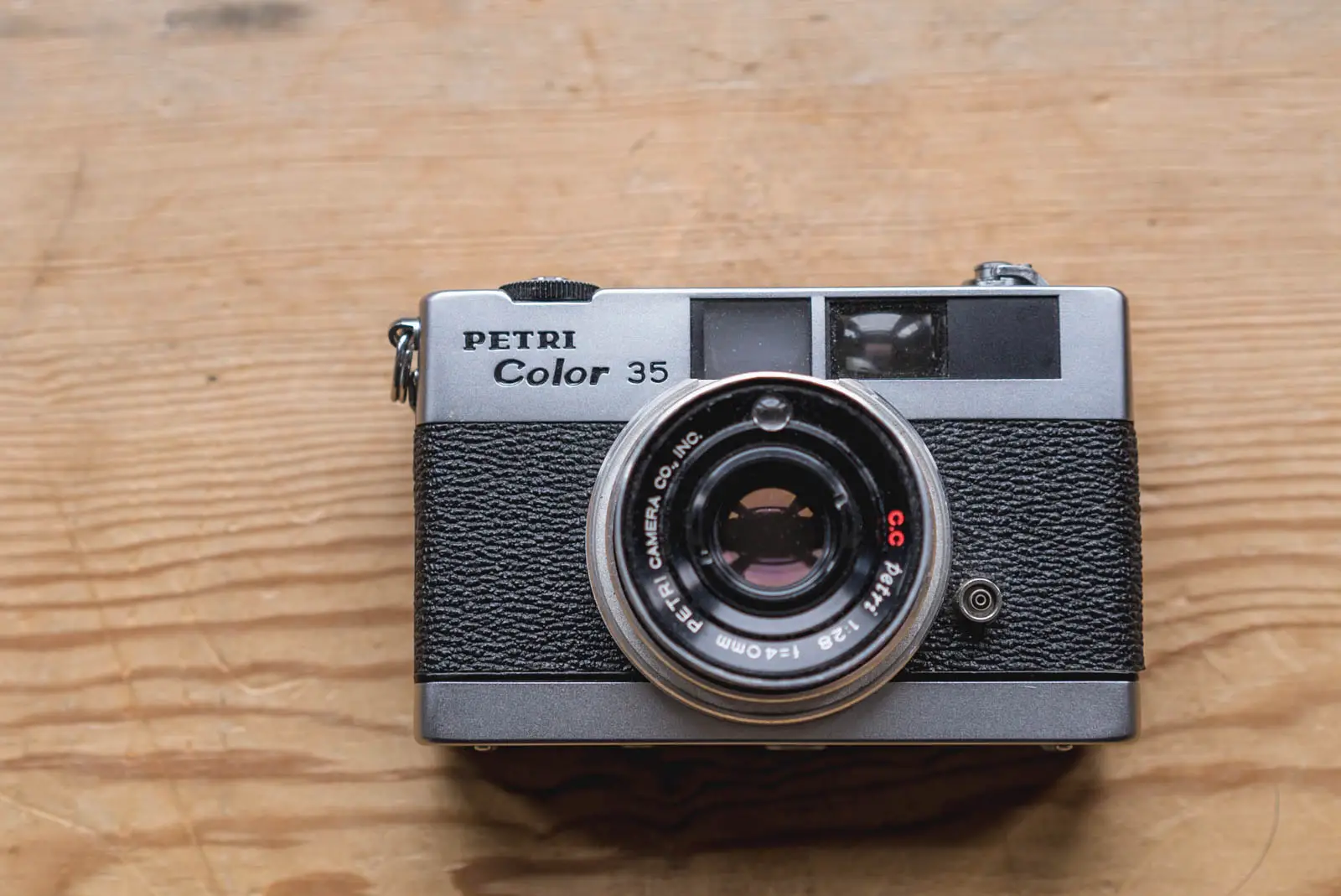
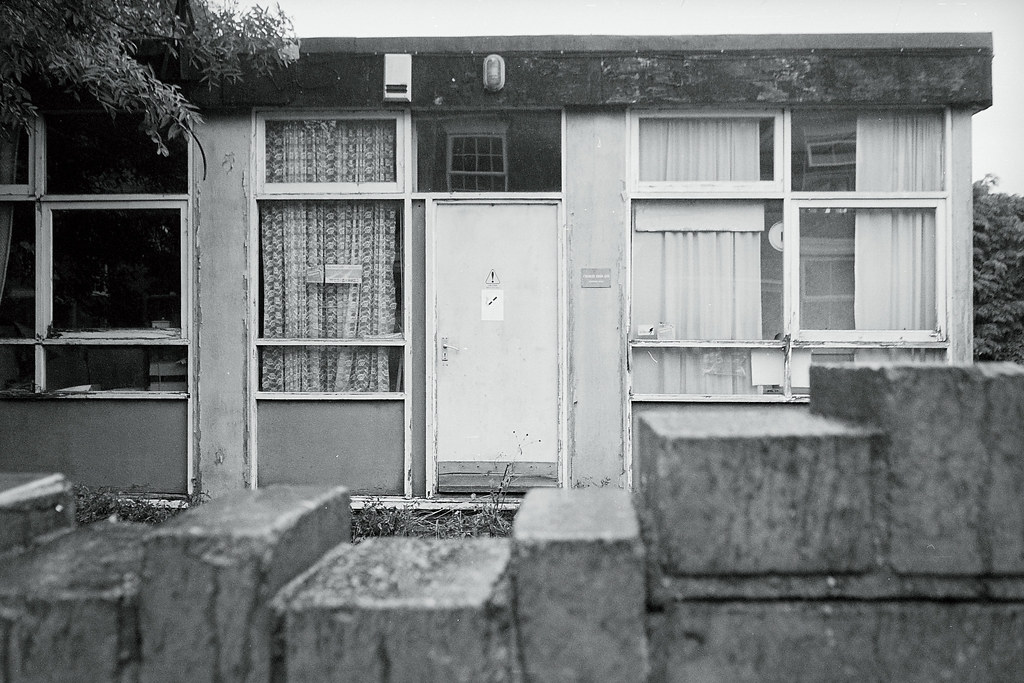
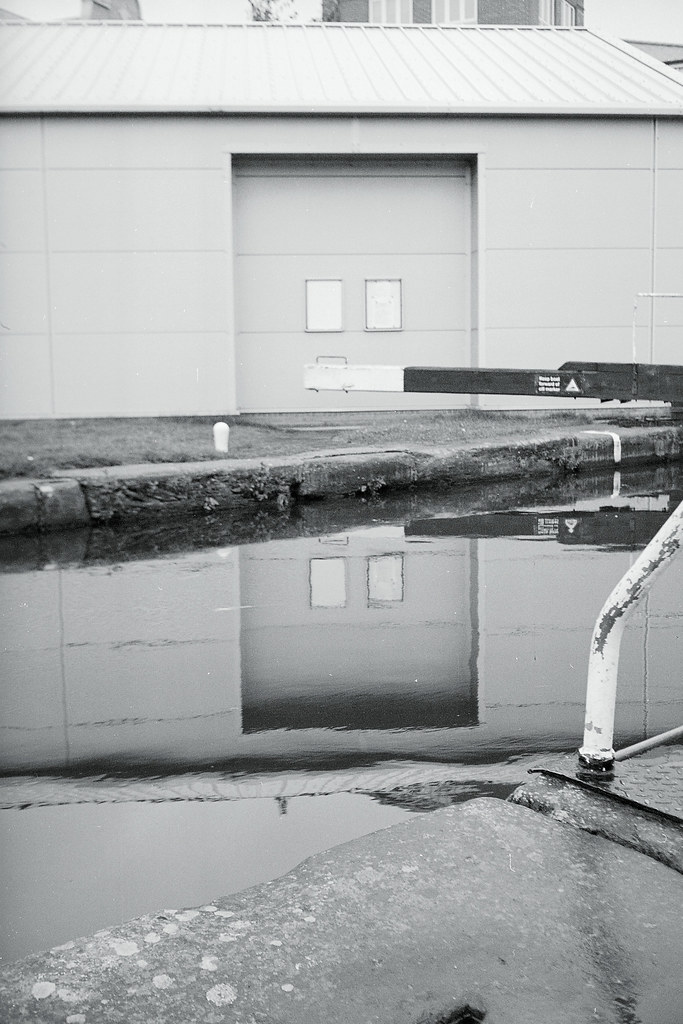
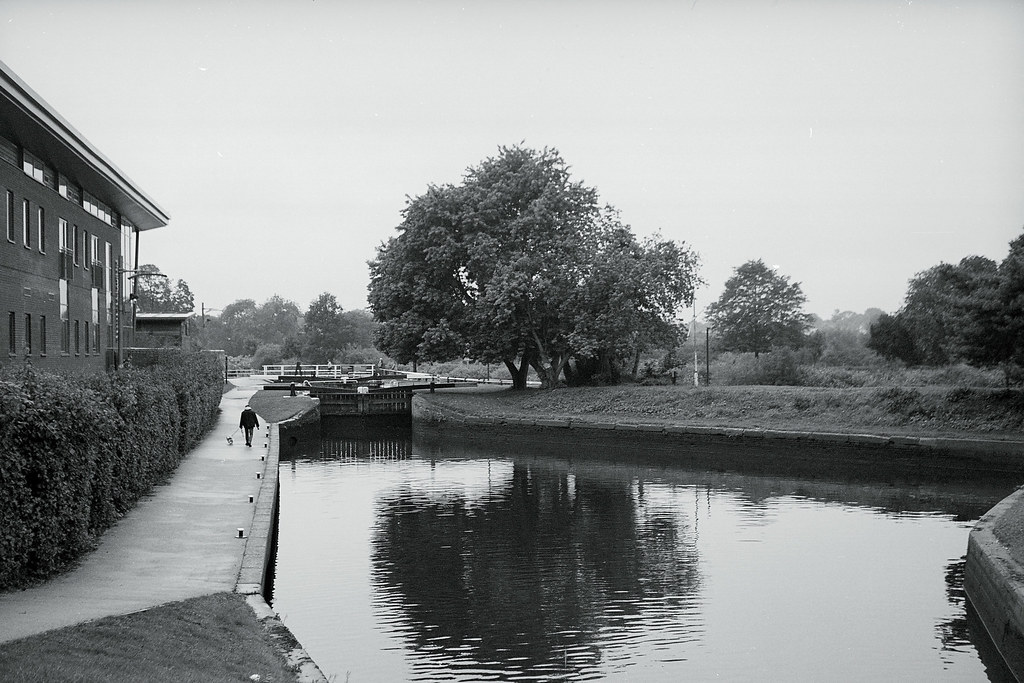
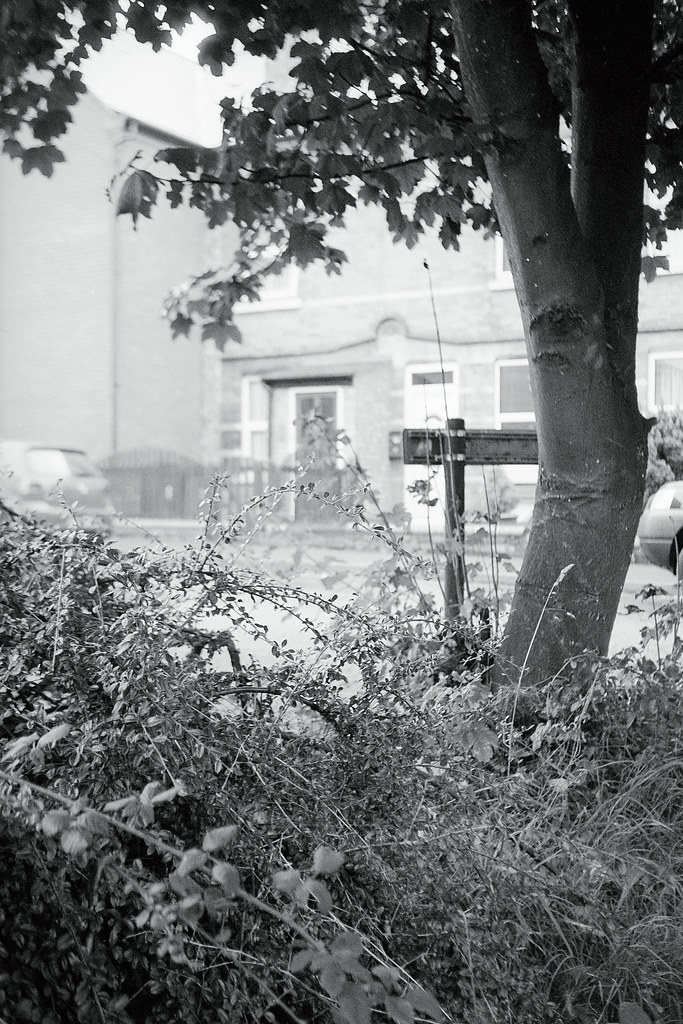
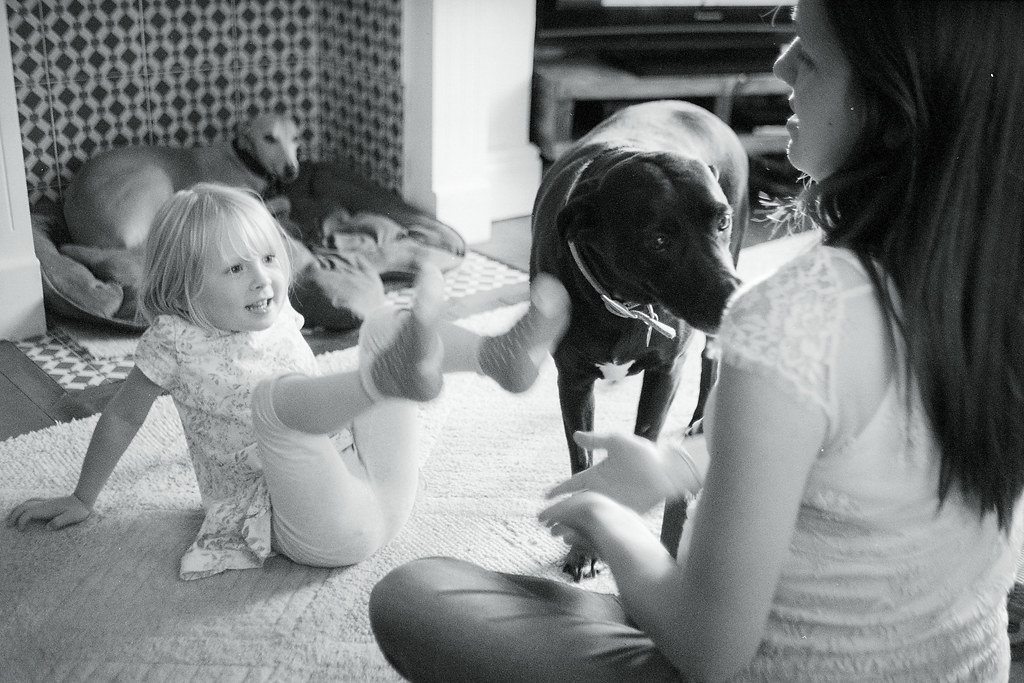
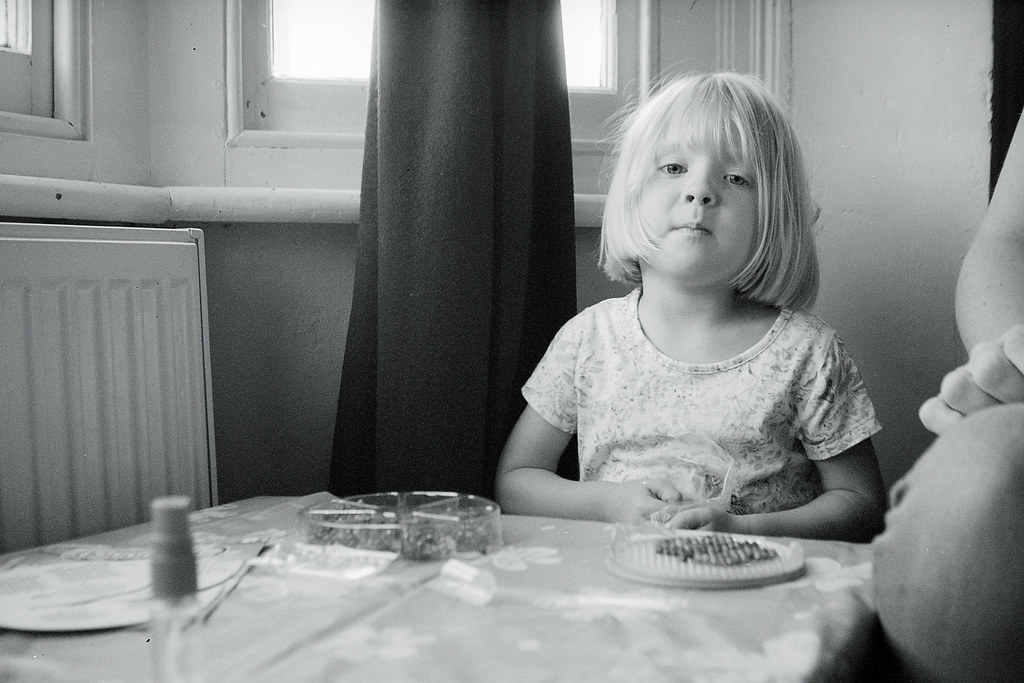
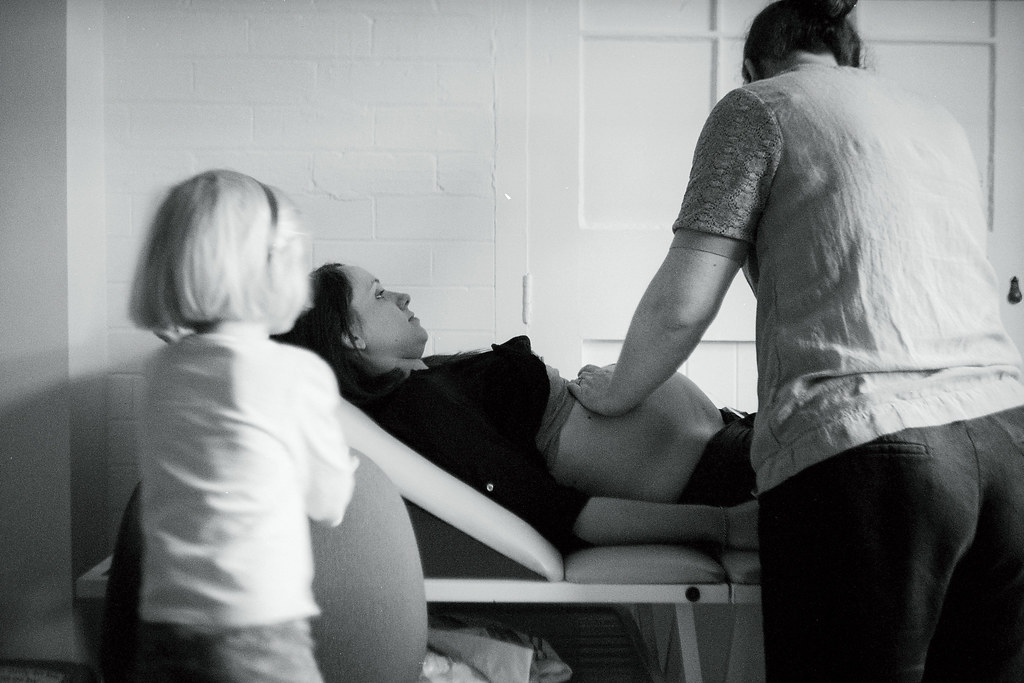








Comments
Blinx on Petri Color 35 Review
Comment posted: 06/09/2015
After a few years using old folding cameras I'd become quite adept at nailing distance even at wide apertures, so the visual aids got in the way. I don't miss a rangefinder and the extra cost and complexity they add, but a good distance scale is priceless on a compact camera.
Comment posted: 06/09/2015
marco north on Petri Color 35 Review
Comment posted: 06/09/2015
Comment posted: 06/09/2015
marco north on Petri Color 35 Review
Comment posted: 06/09/2015
Comment posted: 06/09/2015
Ray on Petri Color 35 Review
Comment posted: 07/09/2015
Comment posted: 07/09/2015
Christos Theofilogiannakos on Petri Color 35 Review
Comment posted: 16/10/2015
Comment posted: 16/10/2015
Comment posted: 16/10/2015
Comment posted: 16/10/2015
Casual Camera Human on Petri Color 35 Review
Comment posted: 25/09/2018
Comment posted: 25/09/2018
Michael S. Goldfarb on Petri Color 35 Review
Comment posted: 28/12/2021
Imagine a world with no sites like this, no way to (quickly OR slowly) look up vast amounts of detail on thousands of cameras and lenses. All we had were magazines like Pop Photo and Modern Photography. And even in NYC, with big dealers like Olden and Willoughby's, not everything being made was available all the time. Markets were national then: I didn't see a box of paper or roll of film made by a company other than Kodak until decades later.
My parents were professional photographers with their own little commercial studio. So from early childhood, I was surrounded by cameras, film, chemistry, huge lights and backgrounds, enlargers and contact printers, gas-fired print driers, equipment for making litho negs for printing plates. I was put to work as soon as I was tall enough to peer over a developing tray - around 1966. I got a Petri Color 35 as my personal carry-around camera in 1969... after already having used Nikkormats and Nikons, and lots of other cameras up to 4x5 (all "important" work was done on sheet film). I'd even already owned my own Minox B submini for a couple of years... because I was a teenager in the spy-mad sixties!
So the Petri Color 35 was my main personal camera for 15 years: I shot hundreds of great shots with it. I never felt its scale focusing system was difficult or counter-intuitive. I never felt its controls were fiddly or difficult. You could do everything - focus, use the match-needle meter, change the aperture or speed - without taking the camera from eye! And I was continuously impressed with the results from its lens at a time when Petri was generally dismissed as a second- or third-string maker. I mean, this camera only cost about $75 at a time when a Nikon F Photomic with a 50/2 was over $400.
Anyway... it's very fine to do comparisons with other compact cameras from before and after, looking back godlike and surveying all of film camera history. Back when we were in the middle of it, the Petri seemed a uniquely qualified compact camera - similar to a Rollei 35, but much less expensive. I loved mine and used it until its shutter seized up in 1983. I've used a lot of great small cameras since, but I'm one of those folks who maintains that the Petri Color 35 remains a little-known classic that was a fun, capable shooter.
Tim on Petri Color 35 Review
Comment posted: 30/08/2023
I’d love to try the Color 35 some day. I have one of its even more forgotten relations, the Petri Micro Compact, which I’ve always really enjoyed. It’s a much more simplified version, with all-automatic exposure (no manual aperture or shutter control) and a collapsible lens (the same 40mm f2.8) that just pops in and out by hand, but it does have focussing distances on the lens along with easy to find detents for the four focussing zones, which the author might even find to be an improvement. Although it’s often derided as a cheapened, cut down Color 35 (which it is), the Micro Compact is still a very solidly built camera and has worked reliably for me for three decades now. It seems one way or another Petri’s always suffer by comparison - if it’s not the Color 35 vs the Rollei, it’s every other Petri vs the Color 35 - and yet really they’re all great cameras in their own way.
It’s a shame IMO that Petri is largely forgotten now - or looked down upon. Taken as a whole, the quality of their camera output (in design and build) was at least as good if not better than many of the bigger names we still laud now. Their marketing and accountancy skills, perhaps less so.
Comment posted: 30/08/2023
Alun Thomas on Petri Color 35 Review
Comment posted: 20/04/2024